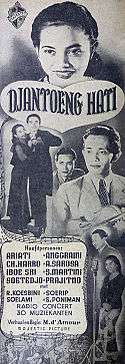Djantoeng Hati
| Djantoeng Hati | |
|---|---|
|
Magazine advertisement | |
| Directed by | Njoo Cheong Seng |
| Produced by |
|
| Written by | Njoo Cheong Seng |
| Starring |
|
| Music by | R. Koesbini |
| Cinematography | The Teng Chun |
Production company |
Majestic Pictures |
Release dates |
|
| Country | Dutch East Indies |
| Language | Malay |
Djantoeng Hati (Heart and Soul) is a 1941 film from the Dutch East Indies directed by Fred Young. A tragedy warning against modernity,[1] it starred A Sarosa, Rr Anggraini, and Ariati
Plot
Two students – the traditional Karina (Rr Anggraini) and metropolitan Roesdjana (Ariati) – are in competition for Karina's husband Sobari (Chatir Harro). Eventually Karina wins out.[1][2]
Production
Djantoeng Hati was written and directed by Njoo Cheong Seng. The film was produced by Fred Young and SI Liem of Majestic Film.[2] It was the company's first production.[1] It starred A Sarosa, Rr Anggraini, Soerip, and Ariati;[2] Njoo's wife Fifi Young, who had previously acted in all his films, was unable to act owing to health reasons.[1][3] Most of its stars were of noble (ningrat) descent, an attempt to draw middle-class audiences,[2] while the story focused on students to draw educated viewers.[1]
The black-and-white film was shot by The Teng Chun, one of Fred Young's friends from when he studied in the United States; The also allowed Majestic to use his studios in Batavia (modern-day Jakarta).[4] The's brother Teng Liong served as sound director. The film featured seven kroncong songs by R. Koesbini which were sung by the main cast.[2]
Release and reception
Djantoeng Hati was released in 1941.[2] Majestic's second film, Air Mata Iboe (Mother's Tears) was released later in 1941. It was their last production before the Japanese occupation the following year.[5]
Djantoeng Hati is likely a lost film. The American visual anthropologist Karl G. Heider writes that all Indonesian films from before 1950 are lost.[6] However, JB Kristanto's Katalog Film Indonesia (Indonesian Film Catalogue) records several as having survived at Sinematek Indonesia's archives, and Biran writes that several Japanese propaganda films have survived at the Netherlands Government Information Service.[7]
References
Footnotes
- 1 2 3 4 5 Biran 2009, p. 240.
- 1 2 3 4 5 6 Filmindonesia.or.id, Djantoeng Hati.
- ↑ Biran 2009, pp. 228–229.
- ↑ Biran 2009, p. 239.
- ↑ Biran 2009, p. 241.
- ↑ Heider 1991, p. 14.
- ↑ Biran 2009, p. 351.
Bibliography
- Biran, Misbach Yusa (2009). Sejarah Film 1900–1950: Bikin Film di Jawa [History of Film 1900–1950: Making Films in Java] (in Indonesian). Jakarta: Komunitas Bamboo working with the Jakarta Art Council. ISBN 978-979-3731-58-2.
- "Djantoeng Hati". filmindonesia.or.id (in Indonesian). Jakarta: Konfidan Foundation. Archived from the original on 25 July 2012. Retrieved 25 July 2012.
- Heider, Karl G (1991). Indonesian Cinema: National Culture on Screen. Honolulu: University of Hawaii Press. ISBN 978-0-8248-1367-3.
